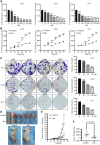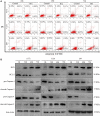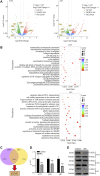Brusatol Inhibits Proliferation and Invasion of Glioblastoma by Down-Regulating the Expression of ECM1
- PMID: 34970146
- PMCID: PMC8713816
- DOI: 10.3389/fphar.2021.775680
Brusatol Inhibits Proliferation and Invasion of Glioblastoma by Down-Regulating the Expression of ECM1
Abstract
Brusatol (Bru), a Chinese herbal extract, has a variety of anti-tumor effects. However, little is known regarding its role and underlying mechanism in glioblastoma cells. Here, we found that Bru could inhibit the proliferation of glioblastoma cells in vivo and in vitro. Besides, it also had an inhibitory effect on human primary glioblastoma cells. RNA-seq analysis indicated that Bru possibly achieved these effects through inhibiting the expression of extracellular matrix protein 1 (ECM1). Down-regulating the expression of ECM1 via transfecting siRNA could weaken the proliferation and invasion of glioblastoma cells and promote the inhibitory effect of Bru treatment. Lentivirus-mediated overexpression of ECM1 could effectively reverse this weakening effect. Our findings indicated that Bru could inhibit the proliferation and invasion of glioblastoma cells by suppressing the expression of ECM1, and Bru might be a novel effective anticancer drug for glioblastoma cells.
Keywords: brusatol; extracellular matrix protein 1; glioblastoma; invasion; proliferation.
Copyright © 2021 Dai, Cai, Chen, Wang, Zhang, Wang, Tu, Zhu, Li and Lu.
Conflict of interest statement
The authors declare that the research was conducted in the absence of any commercial or financial relationships that could be construed as a potential conflict of interest.
Figures







Similar articles
-
Brusatol Inhibits Proliferation and Metastasis of Colorectal Cancer by Targeting and Reversing the RhoA/ROCK1 Pathway.Biomed Res Int. 2022 May 18;2022:7132159. doi: 10.1155/2022/7132159. eCollection 2022. Biomed Res Int. 2022. Retraction in: Biomed Res Int. 2024 Mar 20;2024:9853485. doi: 10.1155/2024/9853485. PMID: 35647190 Free PMC article. Retracted.
-
Brusatol inhibits HIF-1 signaling pathway and suppresses glucose uptake under hypoxic conditions in HCT116 cells.Sci Rep. 2016 Dec 16;6:39123. doi: 10.1038/srep39123. Sci Rep. 2016. PMID: 27982118 Free PMC article.
-
Brusatol Derivative-34 Attenuates Allergic Airway Inflammation Via Inhibition of the Spleen Tyrosine Kinase Pathway.Front Pharmacol. 2021 Mar 30;12:587417. doi: 10.3389/fphar.2021.587417. eCollection 2021. Front Pharmacol. 2021. PMID: 33859559 Free PMC article.
-
ECM1 promotes migration and invasion of hepatocellular carcinoma by inducing epithelial-mesenchymal transition.World J Surg Oncol. 2016 Jul 27;14(1):195. doi: 10.1186/s12957-016-0952-z. World J Surg Oncol. 2016. PMID: 27460906 Free PMC article.
-
The extracellular matrix protein 1: its molecular interaction and implication in tumor progression.Cancer Invest. 2008 May;26(4):375-84. doi: 10.1080/07357900701788148. Cancer Invest. 2008. PMID: 18443958 Review.
Cited by
-
Antitumor Effect of Brusatol in Acute Lymphoblastic Leukemia Models Is Triggered by Reactive Oxygen Species Accumulation.Biomedicines. 2022 Sep 6;10(9):2207. doi: 10.3390/biomedicines10092207. Biomedicines. 2022. PMID: 36140308 Free PMC article.
-
Extracellular Matrix Protein 1 Regulates Colorectal Cancer Cell Proliferative, Migratory, Invasive and Epithelial-Mesenchymal Transition Activities Through the PI3K/AKT/GSK3β/Snail Signaling Axis.Front Oncol. 2022 Apr 27;12:889159. doi: 10.3389/fonc.2022.889159. eCollection 2022. Front Oncol. 2022. PMID: 35574325 Free PMC article.
-
Shedding light on function of long non-coding RNAs (lncRNAs) in glioblastoma.Noncoding RNA Res. 2024 Feb 6;9(2):508-522. doi: 10.1016/j.ncrna.2024.02.002. eCollection 2024 Jun. Noncoding RNA Res. 2024. PMID: 38511060 Free PMC article. Review.
-
Endosome associated trafficking regulator 1 promotes tumor growth and invasion of glioblastoma multiforme via inhibiting TNF signaling pathway.J Neurooncol. 2024 Jan;166(1):113-127. doi: 10.1007/s11060-023-04527-9. Epub 2024 Jan 8. J Neurooncol. 2024. PMID: 38191954
-
Extracellular matrix protein 1 (ECM1) is a potential biomarker in B cell acute lymphoblastic leukemia.Clin Exp Med. 2024 Mar 28;24(1):56. doi: 10.1007/s10238-023-01255-2. Clin Exp Med. 2024. PMID: 38546916 Free PMC article.
References
-
- Bovilla V. R., Kuruburu M. G., Bettada V. G., Krishnamurthy J., Sukocheva O. A., Thimmulappa R. K., et al. (2021). Targeted Inhibition of Anti-inflammatory Regulator Nrf2 Results in Breast Cancer Retardation In Vitro and In Vivo . Biomedicines 9, 1119. 10.3390/biomedicines9091119 - DOI - PMC - PubMed
LinkOut - more resources
Full Text Sources
Molecular Biology Databases
Research Materials
Miscellaneous

